Build A Bigger Upper Body With This Four-Week Programme
Get strong with this three-workouts-a-week chest, back and shoulders plan
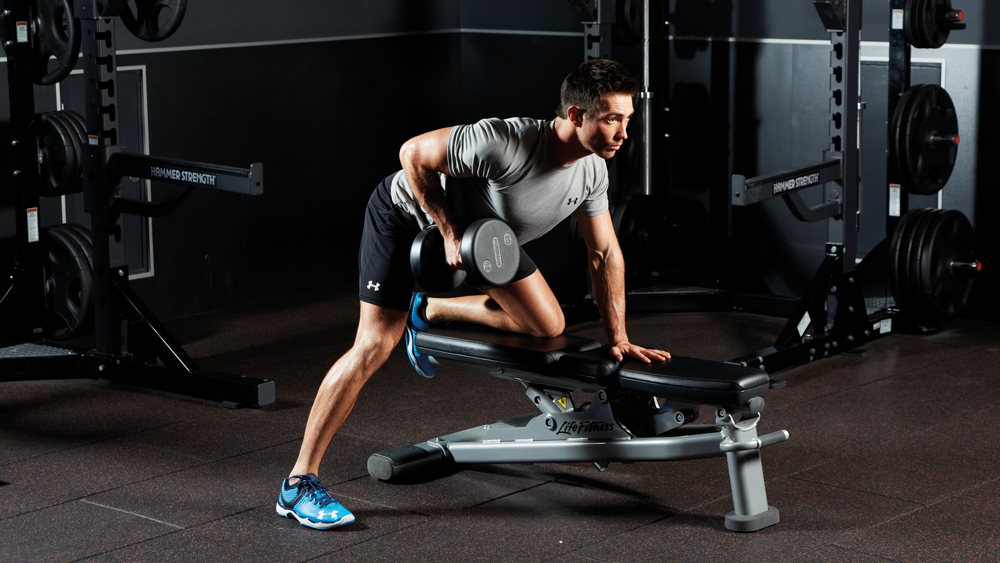
While we would never advise you to avoid training your legs for an extended period of time, we recognise that you might want to devote more attention to some muscles than you do to others. Each workout in this plan is devoted to a major upper body muscle group – your chest, back and shoulders. Follow them faithfully and you’ll add strength and size up top.
Follow the sets, reps and rest instructions for each move to get the maximum benefit. Do each workout once a week for four weeks, aiming to increase the amount you lift each time. And make sure you make a note of how much you lift in each session to keep yourself motivated.
Once you’ve completed this plan, make sure to include some legs workouts in your routine, then graduate to this four-workouts-a-week upper-body workout plan.
Workout 1: Chest
1 Dumbbell bench press

Sets 3 Reps 10 Rest 60sec
Why Using dumbbells for this classic chest-builder emphasises your pecs more than the barbell version, because the dumbbells move slightly inwards throughout the rep and also go through a greater range of motion, which will warm them up before you go heavy in the classic bench (see below).
How Lie on a bench with your feet on the floor directly under your knees. Hold the dumbbells above you with arms straight, then lower them to your chest. Drive your feet hard into the floor and push the weights back strongly to the start position.
2 Bench press
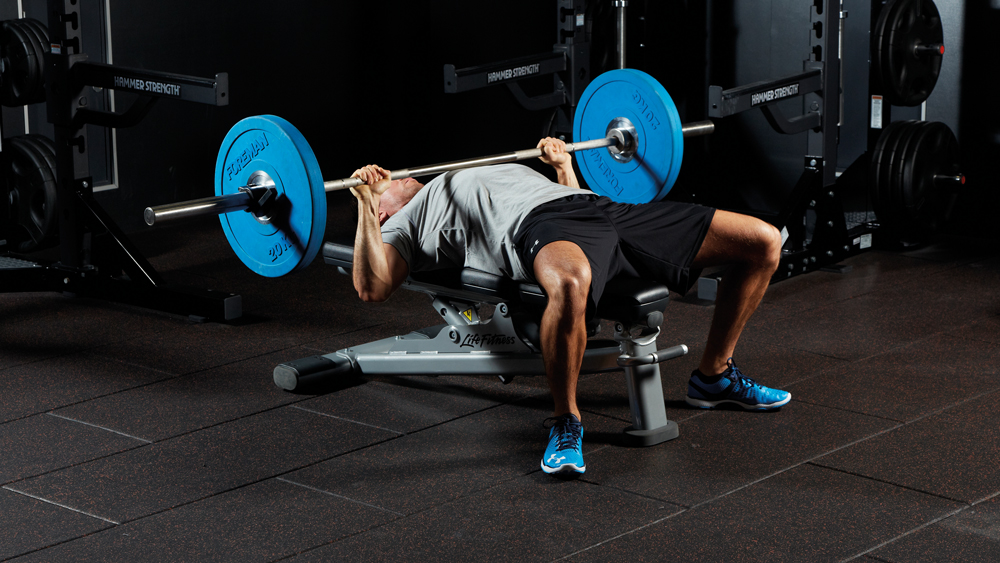
Sets 5 Reps 5 Rest 60-90sec
Sign up for workout ideas, training advice, reviews of the latest gear and more.
Why It’s a classic for a reason: a properly executed bench press (with your feet pressing into the floor) will tax your whole body and allow you to use heavy weights to maximise upper-body development. Ensure your form is correct to avoid injury and maximise growth.
How Take a grip slightly wider than shoulder width and squeeze your lats together to create a pressing platform before you take the bar out of the rack. Watch the ceiling, not the bar, to ensure you’re pressing in the same line each time – then lower the bar to your chest, aiming to brush your T-shirt without bouncing. Press up powerfully, pause at the top, then go into your next rep.
3 Incline bench press
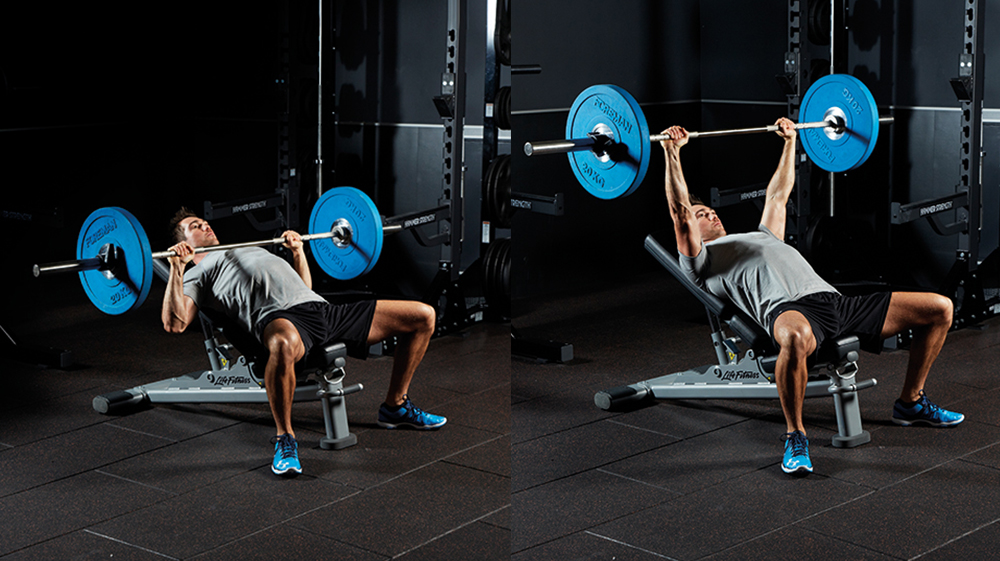
Sets 4 Time 6-8 Rest 60-90sec
Why Setting the bench to an incline will mean you need to reduce the weight – especially once your muscles are fatigued from the previous two moves – but it’ll hit your chest from a new angle.
How Lie on a bench set at a 45˚ incline, holding a bar over your chest with your grip just wider than shoulder width. Lower the bar until it’s touching your chest, then press it back up.
4 Dumbbell pull-over
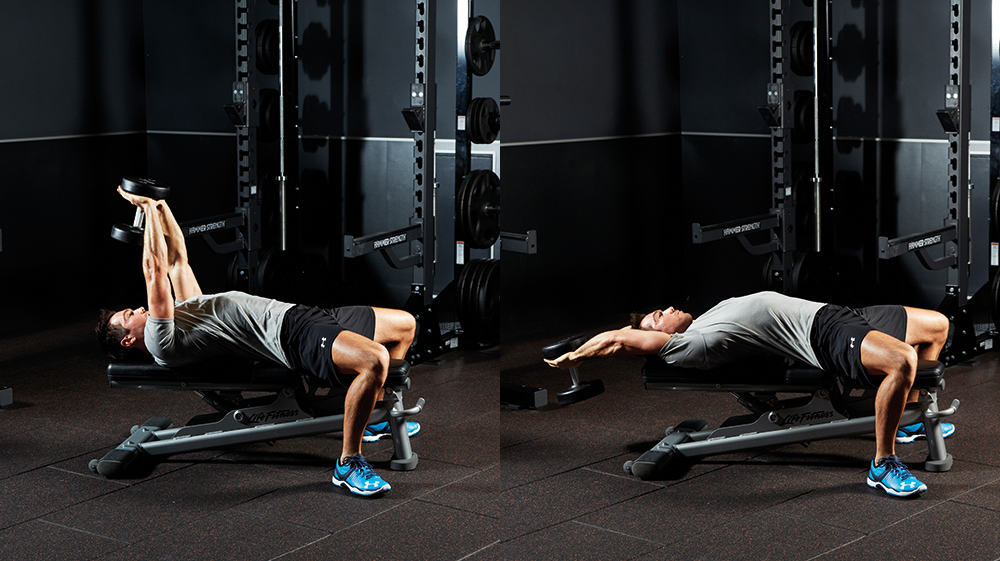
Sets 3 Reps 10 Rest 60sec
Why This move simultaneously works both your chest and your back. That’s useful because when you’re doing a heavy bench press, you want to recruit your lats – the big back muscles – to give yourself a stable base from which you can press.
How Lie on a flat bench and hold a dumbbell in both hands above your face. Keeping your arms straight, lower the dumbbell behind your head until your arms are parallel with the floor. Then bring it back to the start.
5 Press-up

Sets 2 Reps To failure Rest 60sec
Why This versatile go-anywhere chest-builder will also work your core, as well as teaching you to hold full-body tension. Because it lets you push yourself with minimal injury risk, it’s a safe way to finish the session.
How Get into a press-up position with your hands just outside shoulder-width apart. Keeping your abs braced, lower your body until your chest touches the floor – keeping your thighs off it – and then press back up.
- The ultimate chest workout
Workout 2: Back
1 Pull-up

Sets 3 Reps 6, 8, 10 Rest 60sec
Why This move’s slightly more functional than its popular cousin, the chin-up, because it builds the muscles you’d use to haul yourself up a cliff (or climbing wall). It also puts more emphasis on your back – getting some solid numbers here guarantees you a V-shape.
How Grasp the bar using an overhand grip with your hands shoulder-width apart. Start from a dead hang with your arms fully extended. Pull yourself up by squeezing your lats together, aiming to bring your elbows behind you. Once your chin is over the bar, slowly lower back to the start.
2 Bent-over row

Sets 5 Reps 5 Rest 60-90sec
Why It’s the best back-builder bar none – plus it’ll balance out your pressing and give you a stable base for pushing-based moves. For a variation as you get more accomplished, try the Pendlay row, where each rep starts on the floor.
How Hold the bar with a shoulder-width grip, bending your knees slightly. Bend at the hips until your torso is at a roughly 45˚ angle to the floor. Pull the bar up to touch your sternum and then lower under control. If you’re moving your upper body to shift the bar, the weight’s too heavy.
3 Dumbbell bent-over row
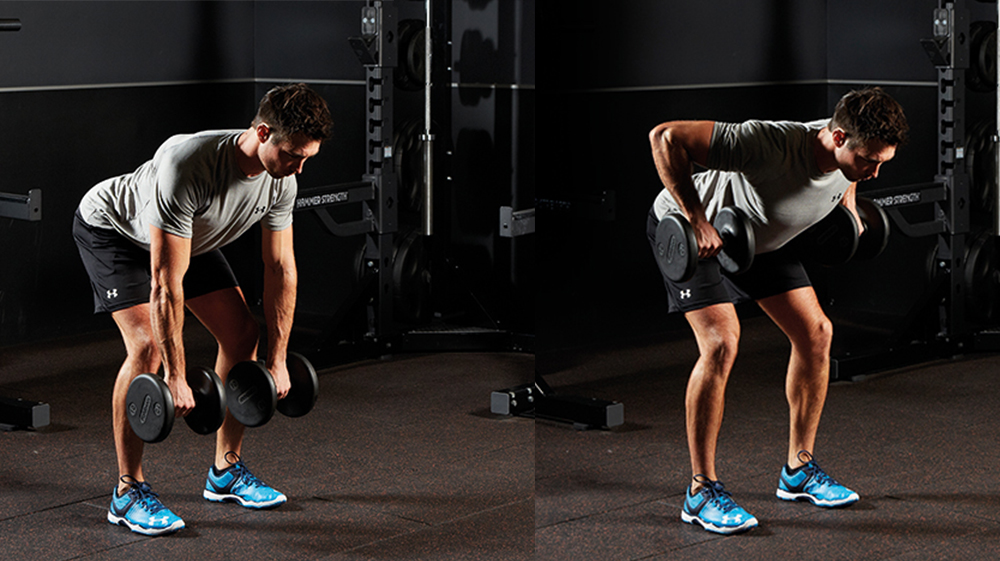
Sets 2 Reps 8-10 Rest 60sec
Why This move will build all the muscles of your back, giving you stability in your shoulder region, improving your posture and balancing out the pressing work you did in the previous session. The dumbbell variation allows your wrists and shoulders to move more freely than the barbell version, improving your range of motion and making it easier to do when you’re starting to get tired.
How Bend at the hips until your torso is at a roughly 45˚ angle to the floor with the dumbbells hanging straight down. Pull the weights up to touch your chest and then lower under control. Again, if you’re using your upper body, you need to reduce the weight.
4 Renegade row
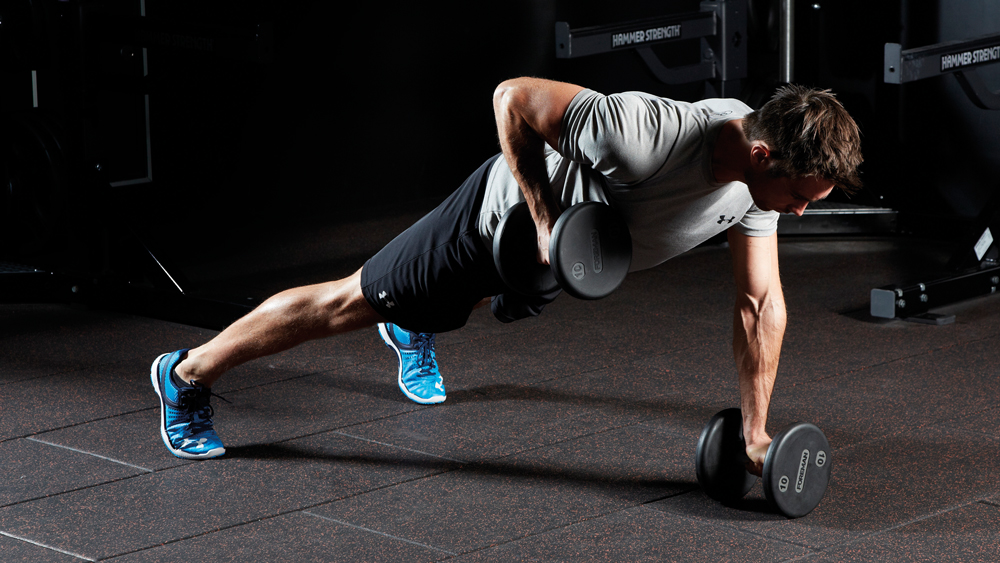
Sets 3 Reps 8 Rest 60sec
Why This move works your back muscles while challenging your stabilisers to keep you level. Think of it as a more brutal version of the plank.
How Start in a press-up position holding dumbbells. Row one dumbbell upwards, so that your thumb touches your armpit, and then the other. Try to stay parallel to the floor - don’t twist.
5 One-arm row

Sets 2 Reps 8 each side Rest 60sec
Why This isolation move works one side of your body at a time, and allows you to shift more weight.
How Set up with one knee resting on a bench and the other foot on the floor, leaning forwards slightly and holding a dumbbell in one hand. Row the dumbbell up until your thumb touches your armpit, then lower.
- Back workouts for the gym to add muscle quickly
Workout 3: Shoulders
1 Kettlebell overhead press
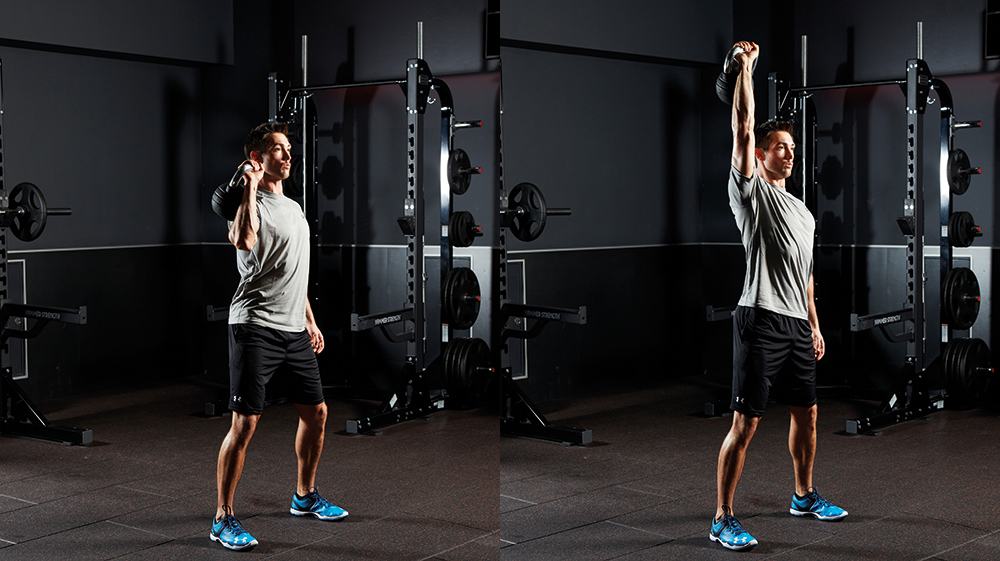
Sets 3 Reps 10 each side Rest 60sec
Why As well as allowing your shoulder joint to rotate more naturally than a barbell press, the one-sided kettlebell version of the press brings your obliques into play, forcing them to work to stabilise your torso. Working your shoulders unilaterally should also fix any imbalances.
How From the rack position, press the kettlebell overhead, keeping the bell resting against your forearm. Lower the bell under control, pausing at the bottom of the move with the bell resting behind your shoulder. Finish all your reps on one side, then switch to the other.
2 Overhead press
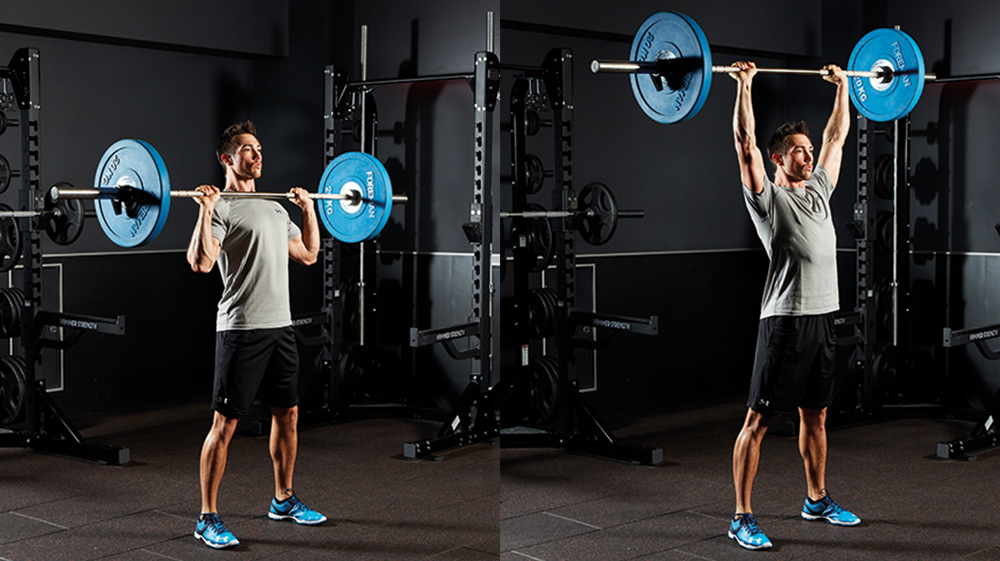
Sets 5 Reps 5 Rest 60-90sec
Why The strict overhead press builds full-body muscle and co-ordination, bringing your abs into the equation to stabilise the weight overhead.
How With your feet shoulder-width apart, position a bar on your upper chest, gripping it with hands just wider than shoulder-width apart. Brace your abs, glutes and quads as you press the bar straight upwards. Pause at the top, then lower. You might find you can lift more weight by wrapping your thumbs around the same side as your fingers, to keep your forearms in a better position. For more overhead press tips, see p86.
3 Push press
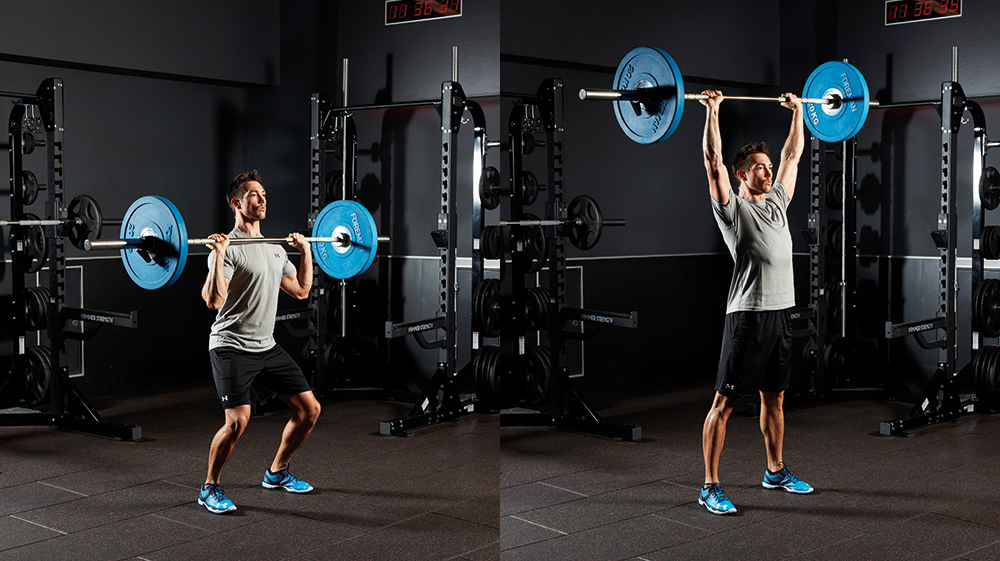
Sets 3 Reps 6-8 Rest 60-90sec
Why Adding explosive drive to the strict press mimics real-life movement – imagine putting a heavy bag into an overhead locker – and allows you to shift more weight than a strict press, while still building full-body explosiveness and co-ordination. It also allows you to complete reps when your shoulders are tired because your legs give each rep momentum.
How Set up in the same position as the overhead press, then do a quarter squat and press the bar overhead as explosively as possible, using the momentum to drive the bar upwards. If you do it properly you shouldn’t be pushing the bar until it’s almost over your head.
4 Lateral raise
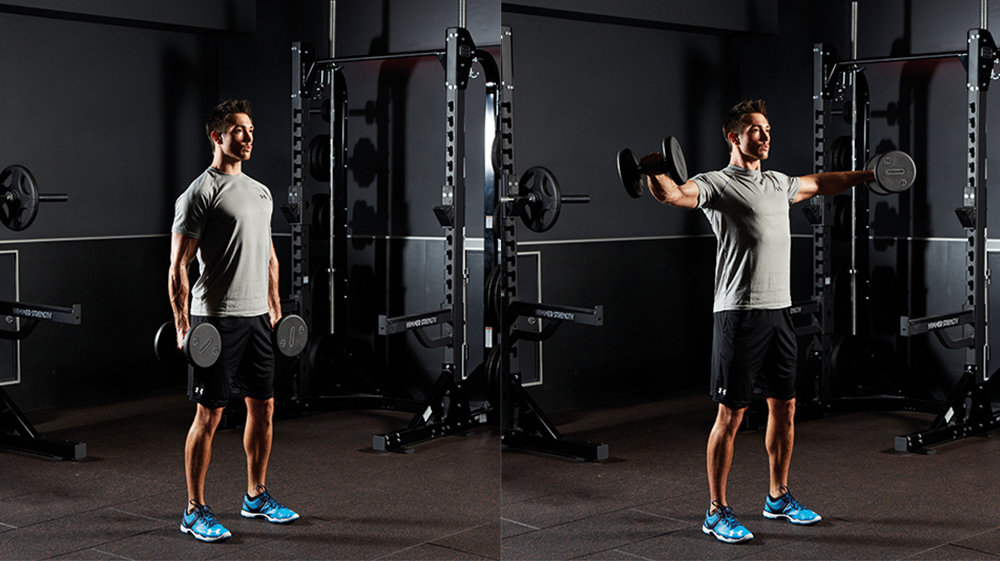
Sets 3 Reps 8-10 Rest 60sec
How Stand tall with your abs braced and feet close but not together, holding a light dumbbell in each hand by your sides with your palms facing one another. Keeping a slight bend in your elbows, raise the weights out to the sides, making sure you use your muscles and not momentum. Stop just below shoulder height, then lower.
5 Reverse flye
Sets 3 Reps 10 Rest 60sec
How Lean forwards at the hips with a weight in each hand. Keeping your back flat, bring the weights upwards as if you were spreading your wings, aiming to bring your shoulder blades together at the top of the move.
- The best shoulder workout routine to add serious size to your shoulders

Joe Warner is a highly experienced journalist and editor who began working in fitness media in 2008. He has featured on the cover of Men’s Fitness UK twice and has co-authored Amazon best-sellers including 12-Week Body Plan. He was the editor of Men’s Fitness UK magazine between 2016 and 2019, when that title shared a website with Coach.
